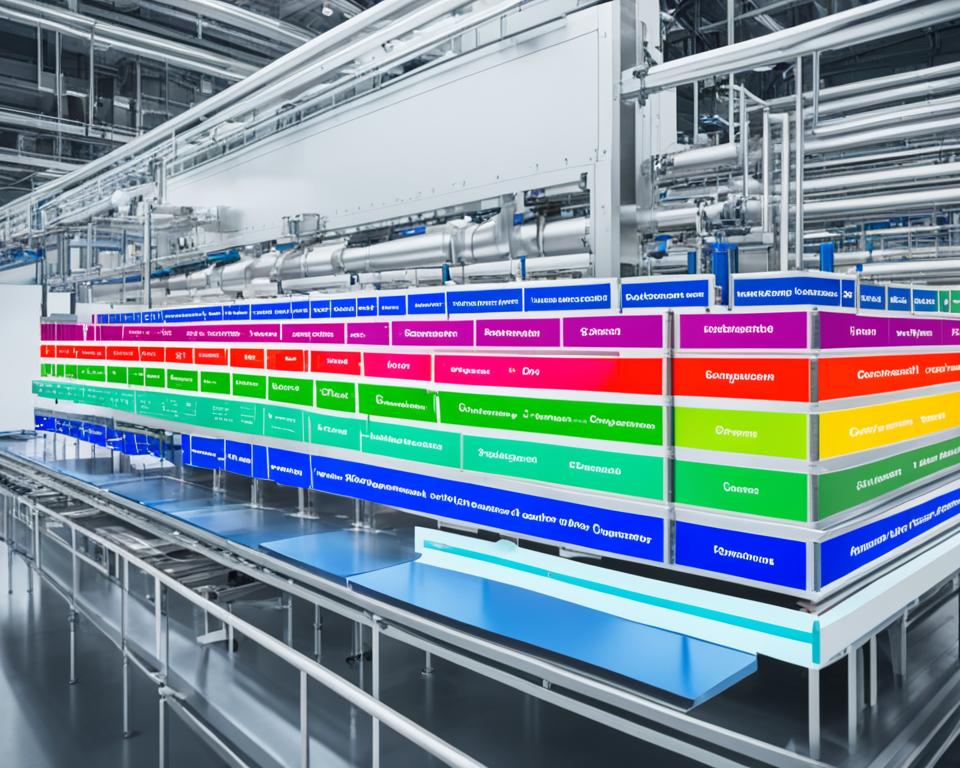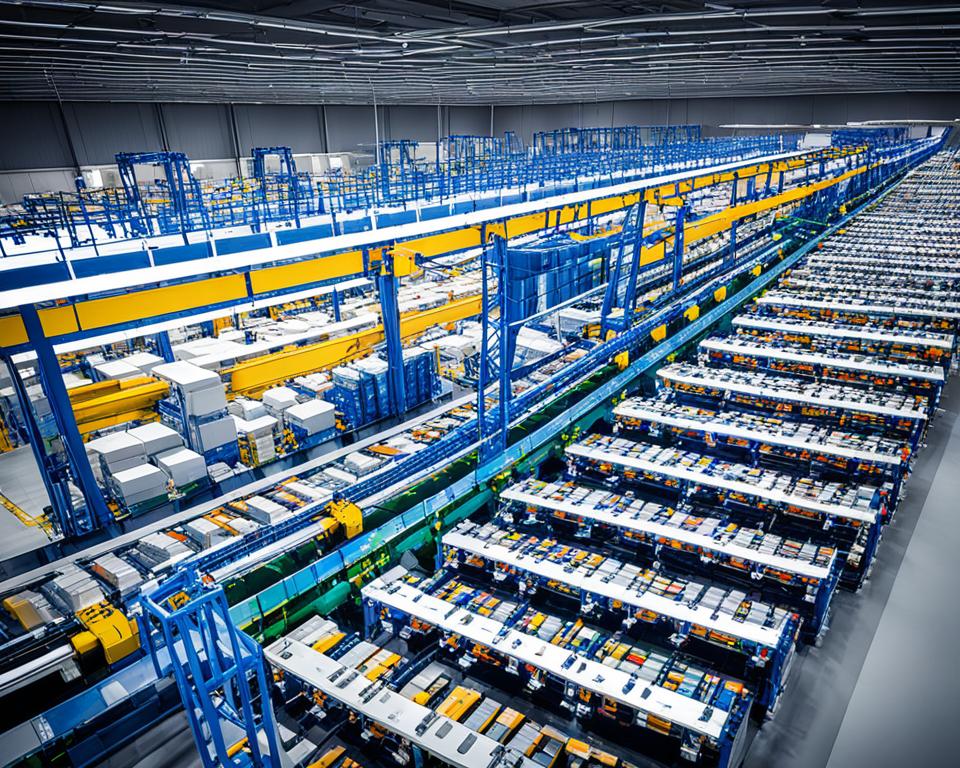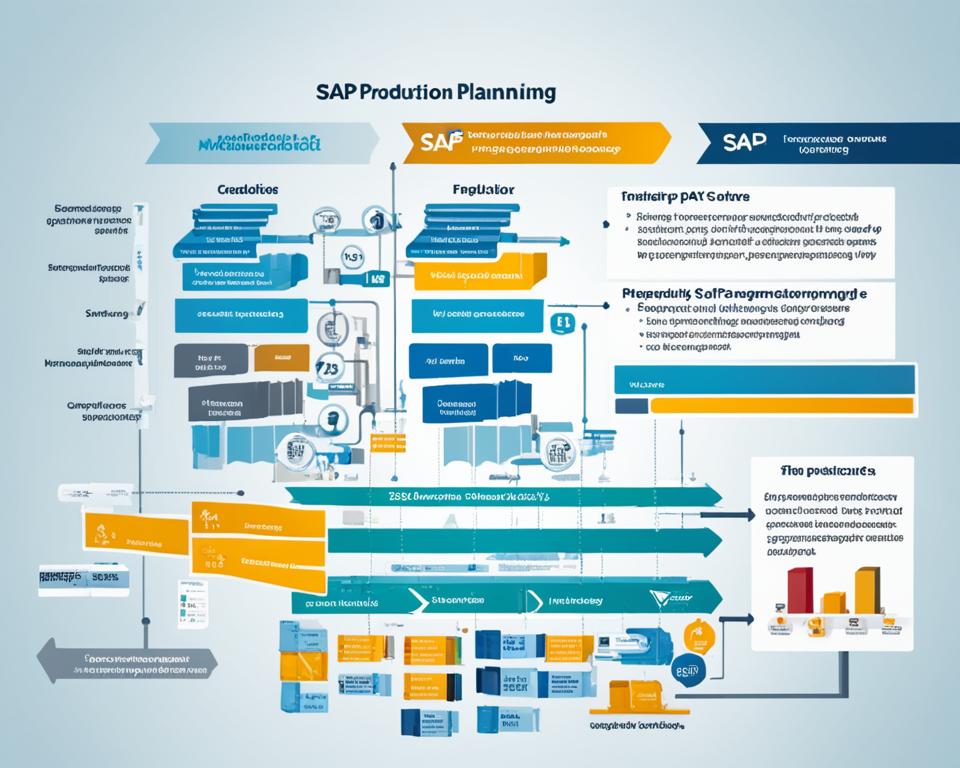Ever wondered how some companies always hit their production targets while keeping costs down and efficiency up? The secret often lies in SAP PP. It’s a key module that helps manage production planning in ERP systems.
I’ll show you how SAP PP helps businesses streamline operations, use resources better, and boost productivity. This article will cover the main features of SAP PP. It’s a must-know for any modern manufacturing company wanting to stay ahead in the game.
Key Takeaways
- SAP PP is key to managing production planning in ERP systems.
- Using SAP PP efficiently improves manufacturing processes and how resources are used.
- Production planning with SAP PP cuts costs and improves supply chain coordination.
- Knowing SAP PP is crucial for businesses aiming for top performance.
- Good production planning with SAP PP leads to happier customers.
Introduction to Production Planning in ERP Systems
Production planning is key to running a smooth manufacturing process. It makes sure resources and processes work together to meet business goals. ERP systems help by managing materials, labor, and schedules in a detailed way.
ERP systems bring together important data from different departments. This helps make quick decisions that improve production. They let companies see problems early and fix them fast. The SAP PP overview shows how production planning works well with other parts of the system.
With SAP PP, companies can predict what they need, plan their resources, and keep track of inventory. This approach helps them quickly adapt to market changes and customer needs. It gives them an edge in today’s fast-paced world.
Understanding SAP PP: An Overview
SAP PP helps us understand the complex production planning module in SAP. It makes sure different manufacturing processes work well together. This includes working with Materials Management (MM) and Sales and Distribution (SD). I’ll show how SAP’s functionality helps share information across departments smoothly.
This approach makes companies more responsive and agile in production. It’s all about making things work better together.

- Routing: Defines the sequence of operations required for production, linking resources effectively.
- Work Center Management: Optimizes resources by assigning tasks based on capabilities and availability.
- Production Order Generation: Facilitates the creation of production orders based on demand forecasts and material availability.
These features show how SAP PP is key to planning production well. By using the module right, I can make sure production is efficient and meets market needs.
The Importance of Material Requirements Planning
Material Requirements Planning (MRP) is key in the SAP PP framework. It makes sure companies have the right materials when they need them. Understanding the main parts of MRP is crucial for its success.
Key Components of Material Requirements Planning
Several important parts make MRP work well, including:
- Inventory Levels: Keeping track of how much material is available helps avoid running out or having too much.
- Lead Times: Knowing how long it takes to get materials helps plan production better.
- Demand Forecasts: Using past sales data to predict future needs helps plan for materials.
Benefits of MRP in Production Scheduling
Using MRP in production planning has many benefits:
- Minimization of Excess Inventory: MRP helps use materials better, cutting down on extra stock.
- Alignment with Actual Sales Forecasts: Accurate predictions of demand lead to better production plans.
- Enhanced Operational Efficiency: MRP makes the flow of materials smoother, improving production.
Capacity Planning in SAP PP
Effective capacity planning is key to boosting productivity in manufacturing. In SAP PP, it helps companies check their production capacity against what they expect to make and when. By looking at what machines and workers they have, I can find ways to use resources better. This ensures all resources are used well and avoids production delays.
How Capacity Planning Enhances Resource Allocation
SAP PP’s tools give insights for planning different scenarios. This lets me change production levels as demand and resources change. With careful planning, I can make sure resources are used well, leading to a smoother workflow and fewer delays. SAP PP has features like:
- Resource Evaluation: Systematic assessment of machine and labor availability.
- Scenario Simulation: Ability to adjust plans based on varying production needs.
- Bottleneck Detection: Finding resource limits in real-time.
Using these tools well can greatly improve production efficiency and make manufacturing more flexible. The table below shows how SAP PP can improve resource use:
| Resource Type | Traditional Allocation | SAP PP Allocation |
|---|---|---|
| Machines | Fixed schedules with little flexibility | Dynamic adjustments based on current capacity |
| Labor | Consistent staffing, often over or under | Adaptive labor assignment based on production needs |
| Materials | Standard order quantities | Just-in-time orders aligned with capacity plans |

Production Scheduling: Streamlining Operations
In manufacturing, production scheduling is key to making things run smoothly. It helps businesses make schedules that change with demand. This is very important in today’s fast market, where delays can cause big problems.
SAP PP implementation gives companies advanced tools to manage their production plans. By sorting production orders, companies can quickly adjust to market changes. This makes them work better, faster, and meet customer needs.
A good production schedule helps make things run better. It makes sure resources are used well and every step of production goes smoothly. Here’s a look at how traditional and SAP PP scheduling compare:
| Aspect | Traditional Scheduling | SAP PP Enabled Scheduling |
|---|---|---|
| Flexibility | Low | High |
| Response Time | Slow | Fast |
| Resource Utilization | Sporadic | Optimized |
| Cycle Time | Longer | Shorter |
Using production scheduling with SAP PP makes things run better and helps with growth and new ideas. For more on SAP and its role in planning, check out this detailed guide on SAP and ABAP programming.
Supply Chain Optimization Through SAP PP
Using SAP PP in business operations greatly improves supply chain management. It offers real-time coordination between planning production and managing inventory. This is key for a well-run supply chain.
Leveraging SAP PP for Enhanced Supply Chain Management
By adding SAP PP, businesses can make their processes smoother and improve communication. Some main benefits are:
- Real-time visibility: Having up-to-date data helps keep inventory in check with production plans. This avoids too much stock or not enough.
- Agility: The system’s flexibility means quick changes can be made to meet market demands. This makes the supply chain more responsive.
- Collaboration: Better relationships with suppliers and distributors lead to smoother coordination. This means fewer delays.
- Cost efficiency: Using resources wisely cuts down on waste and lowers costs in the supply chain.
Using SAP PP well helps improve relationships and gives a competitive edge. Knowing these SAP PP benefits can help businesses aim for a more efficient, agile, and strong supply chain.

Embracing Lean Manufacturing Principles
In today’s fast world, I see how important lean manufacturing is. It cuts waste and boosts value, which is what I aim for in my work. SAP PP helps me a lot with this goal.
Using Just-in-Time (JIT) production helps me manage my work and stock better. This makes my work faster and more efficient. SAP PP support helps me make my processes better and use fewer resources, making me more productive.
Lean manufacturing and SAP PP work well together. They make it easier for companies to improve all the time. Using tools from Ariba makes buying things better and helps lean principles work even better.
This approach makes my production better and helps me work with suppliers better. In short, lean manufacturing and SAP PP support make my work better. They help me compete better in the market.
Just-in-Time Production and Its Impact on Efficiency
Just-in-Time production is key to making things more efficient and cutting waste. It makes sure materials are there when they’re needed, making the production process smoother. SAP PP integration is vital for this method. It matches production with demand, cutting down on extra stock and costs.
This method helps manage stock better and lets companies quickly adapt to changes in the market. It makes sure supply and production work together well. This leads to better use of resources and saves money.
- Minimized carrying costs
- Improved production flow
- Enhanced responsiveness to market changes
- Reduction in waste
Using Just-in-Time production with SAP PP brings big benefits for how things run. It focuses on making things more efficient and making production quick to respond to what customers want.
Effective Inventory Management Strategies
Keeping the right amount of stock is key for businesses. SAP PP helps streamline inventory, keeping stock balanced. This balance is vital for smooth production.
Managing Stock Levels with SAP PP
SAP PP offers tools to predict demand and keep an eye on stock. This helps make smart choices about buying, avoiding too much stock. Using SAP PP with cloud tech gives a clear view of inventory.
Here’s how good inventory management can change things:
| Inventory Management Strategy | Benefits | Key Tools in SAP PP |
|---|---|---|
| Demand Forecasting | Aligns stock levels with customer needs, reducing waste. | Forecasting tools |
| Real-time Monitoring | Enables quick response to stock changes, increasing efficiency. | Dashboard analytics |
| Automated Reordering | Streamlines the procurement process, minimizing manual errors. | Purchase Order Management |
Using these strategies with SAP PP boosts my inventory management. For businesses wanting to improve, checking out SAP Ariba can offer new insights on buying and working with suppliers.
Resource Allocation for Maximum Effectiveness
Getting the most out of resources is key in SAP PP. It’s about using labor and equipment well to hit production goals and save money. SAP has tools that help check on resources. This makes sure workers, machines, and materials work together well to boost output and cut downtime.
Knowing how resources and production work together is important. It means looking at things like:
- Spotting what slows down production.
- Using data to keep an eye on how resources are used.
- Planning ahead to make sure resources are ready when needed.
These steps make production more flexible. Being able to quickly adjust to demand changes can really help a company do well. With SAP’s advanced tools, businesses can change how they use resources to keep up with the market.

Putting resources together with a clear plan helps get the best results in production. By using data insights, companies can improve how they use resources. This leads to better current operations and helps with growth and staying competitive. For more on improving processes, check out how SAP Ariba Modules can help with procurement and managing resources through cloud solutions.
The Role of Demand Forecasting in SAP PP
Demand forecasting is key in production planning, making SAP PP more efficient. It helps predict what customers will need, so companies can plan better. This prevents running out of stock or making too much.
In SAP PP, past sales and market analysis help make accurate demand forecasts. This way, companies can use their resources well. They make sure they have enough supply for demand. Using data helps make operations better and keeps customers happy.
Forecasting demand helps make production planning smoother and cuts down on inventory costs. By knowing what the market needs, companies can use their resources better. This leads to a more flexible operation that can quickly adapt to new trends.
- Enhanced production efficiency
- Reduced operational costs
- Improved customer satisfaction
By using demand forecasting in SAP PP, companies can match their production with market needs. This smart move leads to better decisions and success in business.
SAP PP: Aligning Production with Market Needs
Aligning production with market needs is key for success. SAP PP shows how this tool can make sure production matches market conditions. It uses data analytics to help businesses quickly adjust to demand changes. This makes them more responsive and agile.
Using past data and current trends helps me adjust production plans. This way, I avoid shortages or making too much. SAP PP’s real-time data analysis helps businesses stay ahead and please customers with timely deliveries.

Advanced analytics give deeper insights into what customers like and buy. With this info, I can tweak production to meet new market needs. Being able to adapt is crucial in a fast-changing world.
- Real-time data analysis for agile production planning
- Historical data usage for demand forecasting
- Customer preference insights for tailored production
Aligning production with market needs boosts efficiency and strengthens customer relationships. Understanding SAP PP’s impact can mean the difference between standing still or growing in today’s competitive world.
Conclusion
Looking back, SAP PP’s role in ERP systems is clear. It boosts production planning by combining various tools. These include material requirements planning (MRP), capacity planning, and inventory management. Together, they make operations more efficient and responsive.
Using SAP PP makes processes smoother and helps companies stay ahead. It aligns production with market needs, leading to better results. Looking at real examples shows how this works in the real world.
For companies facing changes in production, SAP PP is key. This article shows how it can change the game in production planning. For more success stories, check out real-world success stories.
FAQ
What is SAP PP and why is it important?
SAP PP stands for Production Planning and is key in ERP systems. It helps manage manufacturing well. It makes sure resources are used right, boosts productivity, and makes operations smoother from start to finish.
How does Material Requirements Planning (MRP) work in SAP PP?
In SAP PP, MRP plans for the materials needed for production. It matches these materials with demand forecasts. This keeps inventory levels right, cutting down on waste and avoiding production stops.
What are the benefits of capacity planning in SAP PP?
Capacity planning in SAP PP looks at how much production can be done. It compares this to what’s needed and planned for. This helps avoid bottlenecks and makes sure people and machines are used well, making operations better.
How does production scheduling improve operations within SAP PP?
Production scheduling in SAP PP makes detailed plans for making things. These plans can change if demand changes. By managing orders and resources well, companies can cut down on delays and make sure products get to customers on time.
Can you explain how SAP PP supports supply chain optimization?
SAP PP helps optimize the supply chain by linking production planning with managing stock. This sharing of real-time data across the supply chain helps companies keep the right stock levels. They can quickly adapt to market changes.
What are lean manufacturing principles and how does SAP PP support them?
Lean manufacturing aims to cut waste and increase value in making things. SAP PP helps by supporting Just-in-Time (JIT) production. This keeps inventory and lead times under control, making operations more efficient.
How does Just-in-Time (JIT) production impact efficiency in SAP PP?
JIT production in SAP PP boosts efficiency by making sure materials are there when needed. This cuts down on storage costs and inventory waste. It lets manufacturers quickly adjust to market changes.
What strategies can help manage inventory effectively using SAP PP?
Managing inventory well in SAP PP means keeping the right amount of stock. This includes using tools for forecasting demand and keeping an eye on stock levels. This helps businesses manage inventory better and save money.
How does SAP PP assist in resource allocation?
SAP PP has tools for analyzing resources like labor and machinery. By matching these resources with production needs, companies can make the most of their resources. This leads to more production and less downtime.
What role does demand forecasting play in SAP PP?
Demand forecasting in SAP PP is key for planning production well. By using past sales data and market analysis, companies can guess future demand. This helps them match supply with market needs, making customers happier.
How does SAP PP help align production with market needs?
SAP PP uses real-time data and advanced analytics to match production with market needs. By adjusting production plans based on market changes, companies can be more responsive. This ensures products get to customers on time.


